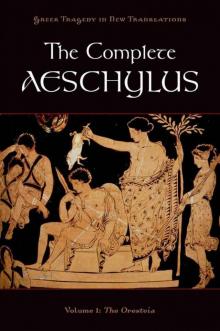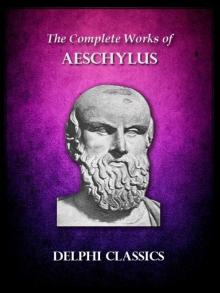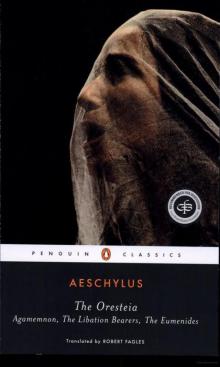The Complete Aeschylus, Volume I: The Oresteia Read online
GREEK TRAGEDY
IN NEW TRANSLATIONS
GENERAL EDITORS
Peter Burian and Alan Shapiro
FOUNDING GENERAL EDITOR
William Arrowsmith
FORMER GENERAL EDITOR
Herbert Golder
THE COMPLETE AESCHYLUS, VOLUME I
The Complete Aeschylus,
Volume I
The Oresteia
Edited by
PETER BURIAN
and
ALAN SHAPIRO
Oxford University Press, Inc., publishes works that further
Oxford University’s objective of excellence
in research, scholarship, and education.
Oxford New York
Auckland Cape Town Dar es Salaam Hong Kong Karachi
Kuala Lumpur Madrid Melbourne Mexico City Nairobi
New Delhi Shanghai Taipei Toronto
With offices in
Argentina Austria Brazil Chile Czech Republic France Greece
Guatemala Hungary Italy Japan Poland Portugal Singapore
South Korea Switzerland Thailand Turkey Ukraine Vietnam
Copyright © 2003, 2011 by Oxford University Press, Inc.
First published by Oxford University Press, Inc., 2003
198 Madison Avenue, New York, New York 10016
www.oup.com
First issued as an Oxford University Press paperback, 2004
Oxford is a registered trademark of Oxford University Press.
All rights reserved. No part of this publication may be reproduced,
stored in a retrieval system, or transmitted, in any form or by any means,
electronic, mechanical, photocopying, recording, or otherwise,
without the prior permission of Oxford University Press.
Library of Congress Cataloging-in-Publication Data
Aeschylus.
[Oresteia. English.]
The complete Aeschylus. v. 1, The oresteia / edited by Peter Burian and Alan Shapiro.
p. cm. — (Greek tragedy in new translations)
Includes bibliographical references.
ISBN 978-0-19-975363-5
1. Aeschylus—Translations into English. 2. Agamemnon (Greek mythology)—Drama.
3. Orestes (Greek mythology)—Drama. 4. Electra (Greek mythology)—Drama.
I. Burian, Peter, 1943– II. Shapiro, Alan, 1952– III. Title. IV. Title: Oresteia.
PA3827.A7B87 2010
882'.01—dc22 2010034461
9 8 7 6 5 4 3 2 1
Printed in the United States of America
EDITORS’ FOREWORD
“The Greek Tragedy in New Translations is based on the conviction that poets like Aeschylus, Sophocles, and Euripides can only be properly rendered by translators who are themselves poets. Scholars may, it is true, produce useful and perceptive versions. But our most urgent present need is for a re-creation of these plays—as though they had been written, freshly and greatly, by masters fully at home in the English of our own times.”
With these words, the late William Arrowsmith announced the purpose of this series, and we intend to honor that purpose. As was true of most of the volumes that began to appear in the 1970s—first under Arrowsmith’s editorship, later in association with Herbert Golder—those for which we bear editorial responsibility are products of close collaborations between poets and scholars. We believe (as Arrowsmith did) that the skills of both are required for the difficult and delicate task of transplanting these magnificent specimens of another culture into the soil of our own place and time, to do justice both to their deep differences from our patterns of thought and expression and to their palpable closeness to our most intimate concerns. Above all, we are eager to offer contemporary readers dramatic poems that convey as vividly and directly as possible the splendor of language, the complexity of image and idea, and the intensity of emotion and originals. This entails, among much else, the recognition that the tragedies were meant for performance—as scripts for actors—to be sung and danced as well as spoken. It demands writing of inventiveness, clarity, musicality, and dramatic power. By such standards, we ask that these translations be judged.
This series is also distinguished by its recognition of the need of nonspecialist readers for a critical Introduction informed by the best recent scholarship, but written clearly and without condescension. Each play is followed by notes designed not only to elucidate obscure references but also to mediate the conventions of the Athenian stage as well as those features of the Greek text that might otherwise go unnoticed. The notes are supplemented by a glossary of mythical and geographical terms that should make it possible to read the play without turning elsewhere for basic information. Stage directions are sufficiently ample to aid readers in imagining the action as they read. Our fondest hope, of course, is that these versions will be staged not only in the minds of their readers but also in the theaters to which, after so many centuries, they still belong.
A NOTE ON THE SERIES FORMAT
A series such as this requires a consistent format. Different translators, with individual voices and approaches to the material at hand, cannot be expected to develop a single coherent style for each of the three tragedians, much less make clear to modern readers that, despite the differences among the tragedians themselves, the plays share many conventions and a generic, or period, style. But they can at least share a common format and provide similar forms of guidance to the reader.
1. Spelling of Greek names
Orthography is one area of difference among the translations that requires a brief explanation. Historically, it has been common practice to use Latinized forms of Greek names when bringing them into English. Thus, for example, Oedipus (not Oidipous) and Clytemnestra (not Klutaimestra) are customary in English. Recently, however, many translators have moved toward more precise transliteration, which has the advantage of presenting the names as both Greek and new, instead of Roman and neoclassical importations into English. In the case of so familiar a name as Oedipus, however, transliteration risks the appearance of pedantry or affectation. And in any case, perfect consistency cannot be expected in such matters. Readers will feel the same discomfort with “Athenai” as the chief city of Greece as they would with “Platon” as the author of The Republic.
The earlier volumes in this series adopted as a rule a “mixed” orthography in accordance with the considerations outlined above. The most familiar names retain their Latinate forms, while the rest are transliterated; -os rather than Latin -us is adopted for the termination of masculine names, and Greek diphthongs (as in Iphigen eia for Latin Iphigenia) are retained. Some of the later volumes continue this practice, but where translators have preferred to use a more consistent practice of transliteration or Latinization, we have honored their wishes.
2. Stage directions
The ancient manuscripts of the Greek plays do not supply stage directions (though the ancient commentators often provide information relevant to staging, delivery, “blocking,” etc.). Hence stage directions must be inferred from words and situations and our knowledge of Greek theatrical conventions. At best this is a ticklish and uncertain procedure. But it is surely preferable that good stage directions should be provided by the translator than that readers should be left to their own devices in visualizing action, gesture, and spectacle. Ancient tragedy was austere and “distanced” by means of masks, which means that the reader must not expect the detailed intimacy (“He shrugs and turns wearily away,” “She speaks with deliberate slowness, as though to emphasize the point,” etc.) that characterizes stage directions in modern naturalistic drama.
3. Numbering of line
s
For the convenience of the reader who may wish to check the translation against the original, or vice versa, the lines have been numbered according to both the Greek and English texts. The lines of the translation have been numbered in multiples of ten, and these numbers have been set in the right-hand margin. The (inclusive) Greek numeration will be found bracketed at the top of the page. The Notes that follow the text have been keyed to both numerations, the line numbers of the translation in bold, followed by the Greek lines in regular type, and the same convention is used for all references to specific passages (of the translated plays only) in both the Notes and the Introduction.
Readers will doubtless note that in many plays the English lines outnumber the Greek, but they should not therefore conclude that the translator has been unduly prolix. In most cases the reason is simply that the translator has adopted the free-flowing norms of modern Anglo-American prosody, with its brief-breath-and-emphasis-determined lines, and its habit of indicating cadence and caesuras by line length and setting rather than by conventional punctuation. Even where translators have preferred to cast dialogue in more regular five-beat or six-beat lines, the greater compactness of Greek diction is likely to result in a substantial disparity in Greek and English numerations.
ABOUT THE TRANSLATIONS
The translations in this series were written over a period of roughly forty years. No attempt has been made to update references to the scholarly literature in the Introductions and Notes, but each volume offers a brief For Further Reading list that will provide some initial orientation to contemporary critical thinking about the tragedies it contains.
THIS VOLUME
In this volume, the General Editors of the series offer their new translation of the only complete Greek tragic trilogy to survive the ravages of time. The plays constitute a continuous drama in three parts, a gripping enactment of the cycle of violent conflict in the House of Atreus finally brought to an end by the no doubt incomplete but deeply hopeful transformation of a regime of vengeance into a rule of law. The Oresteia is at once a great defining monument of classical Greek civilization and one of the most admired and influential classics in all of European dramatic literature.
CONTENTS
INTRODUCTION
ON THE TRANSLATION
Agamemnon
Libation Bearers
Eumenides
NOTES
Agamemnon
Libation Bearers
Eumenides
GLOSSARY
FOR FURTHER READING
THE ORESTEIA
Translated by
ALAN SHAPIRO
and
PETER BURIAN
INTRODUCTION
THE NATURAL HISTORY OF JUSTICE
Aeschylus’ Oresteia, first performed in Athens in 458 B.O.E., is the sole surviving Greek tragic trilogy, and one of those peaks (like Dante’s Comedy, Michelangelo’s frescoes for the Sistine Chapel, or Bach’s St. Matthew Passion) that loom above the other mountains of Western culture as defining expressions of their age. The presentation by each tragic poet of three tragedies performed in a row was ordained by the rules of the competition at the Great Dionysia in Athens, but there was no requirement to offer three tragedies connected by subject. We know that Sophocles and Euripides did not usually do so. Indeed, Aeschylus may have been the only tragic playwright to use the trilogy on a regular basis as, in effect, a gigantic single drama in three parts. By a happy accident, the one Greek tragic trilogy that has survived the ravages of time nearly intact is exemplary in its structure: three plays, each a whole in its own right but each needing the others to complete the form and meaning of a far greater whole.1 And to judge from such evidence as the references to the Oresteia in the comedies of Aristophanes and the reflection of at least two of its plays in vase painting, the Greeks themselves regarded this trilogy as among Aeschylus’ greatest achievements.
The myth that Aeschylus chose to dramatize in the Oresteia was already familiar to his audience in basic outline, and many would have known a range of earlier poetic versions. None of the Greek poets simply versify a given story; all rethink it with their own changes and additions, and in this sense they are themselves mythmakers. The tale of Agamemnon’s death and its aftermath told in Homer’s Odyssey, the earliest and best known version before Aeschylus, is surprisingly different from that in the Oresteia. In the Odyssey, Agamemnon’s disastrous homecoming serves as a contrast to Odysseus’ difficult but successful return and reunion with his faithful wife—and a warning along the way. Clytemnestra’s betrayal of her husband with his cousin Aegisthus, left at home to be her guardian, makes for the strongest possible contrast with Penelope, Odysseus’ faithful wife. Orestes, risking all to avenge his father’s death, becomes a model of courage and duty for Telemachus, Odysseus’ inexperienced and indecisive son, to follow. Aegisthus, not Clytemnestra, does the actual killing of Agamemnon, no moral question is raised about Orestes’ matricide, and no furies pursue Orestes to exact revenge. To judge from the surviving fragments of other retellings, it was the sixth-century Sicilian lyric poet Stesichorus who offered the most important precedents for Aeschylus’ treatment of the story. In Stesichorus, for example, Clytemnestra dreamed about a serpent as she does in Libation Bearers, although apparently the serpent in Stesichorus represented Agamemnon, not Orestes as in Aeschylus; and Apollo offered Orestes protection from his mother’s Erinyes as he does in Eumenides, but only by giving him a bow to ward off his attackers. We can only speculate how much of Aeschylus’ version is original to him, although given the greatness of the dramatic poetry, the question of originality in plot hardly seems relevant (as with Shakespeare’s use of his many sources). There is every reason to believe, however, as we shall see, that Aeschylus’ daring solution to the problem of Orestes’ guilt—trial and acquittal of the crime of matricide by an Athenian court—is entirely new.
Aeschylus’ story of a court founded in Athens to try cases of homicide suggests the direction in which his version of the myth is headed. He will use the structure of the trilogy to offer a sustained dramatic and poetic argument on a theme of universal interest: the evolution of justice in human society from blood vengeance to the rule of law. As one might expect, however, the terms in which the argument unfolds are highly specific to their historical context, and this cultural “otherness” makes it important to establish the idea of justice firmly in its Greek setting. Dikê, the Greek word usually translated “justice,” has a broad spectrum of meanings from quite abstract (designating what is right, proper, or fitting) to specifically legal (denoting trial or punishment), but it may equally well refer not to a human institution or custom at all, but to a broader conception of order and balance. At its furthest extension, for example in the usage of the Presocratic philosophers, dikê indicates nothing less than a cosmic ordering principle. Plutarch cites Heraclitus of Ephesus, the “dark philosopher” who was an older contemporary of Aeschylus, as declaring: “Sun will not overstep his measures, but if he does, the Erinyes, ministers of Dikê, will find him out.”2 (The Erinyes, or Furies, will appear in more than one form as agents of justice in the Oresteia.) This is evidently an illustration of the principle of order in nature, in which Dikê is the personifiction of balance, the guarantor of a necessary regularity in the movements of the heavens. The same point had already been made in reverse, as it were, in a fragment of the sixth-century thinker Anaximander of Miletus, about nothing less than the existence of the physical world itself. This fragment asserts that all things that come into being and perish do so “according to necessity, for they pay the penalty (dikê) and retribution to each other for their injustice (a-dikia) according to the disposition of time.”3 It is usually said that Anaximander is using a legal metaphor here, but it is also important to notice that this fragment, like that of Heraclitus, suggests a notion of dikê as something more than a customary legal standard. Dikê in both fragments expresses a fundamental, natural principle, enforced by necessity, on the
grandest possible scale. The principle is balance, and its enforcement takes the form of retribution to redress imbalance. Retribution comes by what agency and at what time it will, but it comes as an equal and opposite reaction to whatever has overstepped its proper bounds.
This is very much the view of dikê presupposed by the first two plays of the Oresteia and modified at last in the third. To put it schematically, Agamenmnon and Libation Bearers show how the ineluctable and destructive power of retributive justice, operating over generations, leads to a profound crisis—familial and civic—that only the final extinction of the house of Atreus seems capable of ending. Up to this point in the trilogy, the story appears to illustrate the workings of what we might call the natural history of justice, a cycle of destruction in which each act feeds off the one before and nourishes the next. Eumenides brings the cycle to a different end by forging new institutions for the operation of a justice that can settle disputes within the framework of a legal system and that thereby fosters the survival of human communities rather than their destruction. (The kind of community in question will turn out, not surprisingly, to be the Greek polis, and the institutions to be a mythical version of those found in Aeschylus’ Athens.) The natural cycle of dikê is not, and cannot be, overturned; rather, it will be transformed, in the end, by the work of gods and mortals who initiate a new, unnatural history of justice.
To see the process of retributive dikê at work in the Oresteia, let us ask why Agamemnon is killed in Agamemnon. Even if the question only means, why does Clytemnestra kill him, the play already offers multiple answers. For Clytemnestra, Agamemnon is first of all the murderer of their daughter, Iphigenia, whom he sacrificed in order to allow his fleet to sail to Troy when Artemis’ wrath had stilled the winds. But there is more: Clytemnestra has taken Aegisthus as her lover in Agamemnon’s absence and intends to rule with him after Agamemnon’s death; and, perhaps paradoxically in the circumstances, but predictably, she is offended by Agamemnon’s arrival with his own new concubine, Cassandra, prominently in tow.

 The Oresteia: Agamemnon, the Libation Bearers, the Eumenides
The Oresteia: Agamemnon, the Libation Bearers, the Eumenides The Complete Aeschylus, Volume I: The Oresteia
The Complete Aeschylus, Volume I: The Oresteia The Complete Aeschylus - Volume I: The Oresteia
The Complete Aeschylus - Volume I: The Oresteia Delphi Complete Works of Aeschylus (Illustrated) (Delphi Ancient Classics)
Delphi Complete Works of Aeschylus (Illustrated) (Delphi Ancient Classics) The Oresteia: Agamemnon, the Libation-Bearers & the Furies
The Oresteia: Agamemnon, the Libation-Bearers & the Furies An Oresteia: Agamemnon by Aiskhylos; Elektra by Sophokles; Orestes by Euripides
An Oresteia: Agamemnon by Aiskhylos; Elektra by Sophokles; Orestes by Euripides